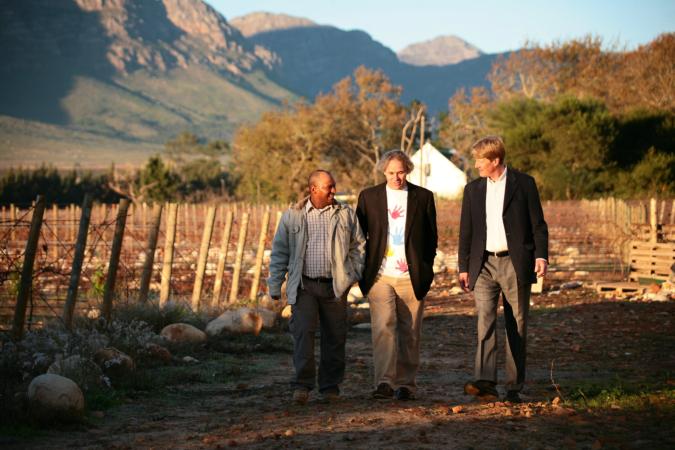While Barack Obama had problems delivering a snotklap to Hilary Clinton yesterday, Mark Solms has made a clean sweep of Manhattan bottle stores, securing shelf space for his Solms-Delta wines in the city’s best wine shop, Sherry-Lehmann on Park Avenue and in one of the ritziest city winebars, Morrell & Co. on Rockefeller Plaza where it will join Le Bonheur on the winelist. That he found a berth in Astor Wine & Spirits on Lafayette Street comes as no surprise, as his partner Richard Astor is a scion of the family that owned the lion’s share of the island in the 19th century. The following story about Mark and Richard appeared in edited form in the Financial Mail last month.

Authenticity is the Holy Grail of wine marketing. Which is why the choice of the brand name “Yattarna” for Penfold’s wannabe white icon of Australian wine – the so-called “white Grange” – was such a strange one. The word “yattarna” is of aboriginal origin, meaning “little by little, gradually.” Which should have raised howls of outrage and charges of cultural exploitation in the wine bars of St. Kilda (Melbourne) and Potts Point (Sydney) – especially given the unfortunate history of Australia’s indigenous population and alcohol. But the Penfold’s marketers had done their job well as the word came from a now extinct South Australian language with no adherents left to press any cultural compensation claims.
At least they got the South Australian bit right, as the grapes for the maiden vintage ’95 were sourced from the McLaren Vale and the Adelaide Hills of South Australia. And the tradition of exploitation continues in the marketing campaign with photos of Senior White Winemaker Oliver Crawford (“only 30… a young man in a hurry) smiling quizzically out of the pages of the Spectator, glass of white in hand, pinstripe trousers and red sneakers.
Of course attaching an employee to an icon can be a risky strategy, as KWV found out with their erstwhile cellar master Kosie Möller and his Perold Shiraz. Likewise adopting an Aboriginal theme is not without risk, as the continent’s indigenous folk are notoriously prickly when it comes to non-aboriginals embracing their symbols and myths.
Andrew Putter’s prize-winning provocative portrait of Maria van Riebeeck singing a Khoikhoi lullaby to her adopted daughter Krotoa at the Spier Contemporary 2007 art exhibition on Dick Enthoven’s Spier wine estate confirms that Australians are not unique in their appropriation of indigenous cultures. The irony is that Krotoa died an alcoholic at the tender age of 31, with her step-dad Jan, founder of the SA wine industry.
Vastrap 2007, a blend of Chenin Blanc, Clairette Blanche and Sémillion, made by Hilko Hegewisch for Mark Solms and Richard Astor in Franschhoek, grasps the Khoikhoi connection with both hands. As the back label states: “Vastrap [trample] music unites Khoesan trance-dance with Dutch folk music. It is played on anything: concertinas, home-made violins, banjos and ‘blik-kitaars.’ The traditional excuse for a Vastrap party was the trampling of a newly laid cow dung floor; but the ancestors are said to have preferred the open air.”
There is one important difference to the Penfold’s model however. Vastrap is produced by a “joint venture between the Solms and Astor families and the Wijn de Caab Trust, the beneficiaries of which are the historically disadvantaged residents and employees of Delta farm and its environs.”
And this is no BEE BS company either, as a visit to the Museum van de Caab on the farm quickly confirms. In a very real sense, the descendents of Krotoa and her Strandloper forebears are now harvesting the fruits of a historical reality that saw the indigenous pastoral communities displaced by European colonists with a curious habit of dividing common grazing land into individual ownership farms.



